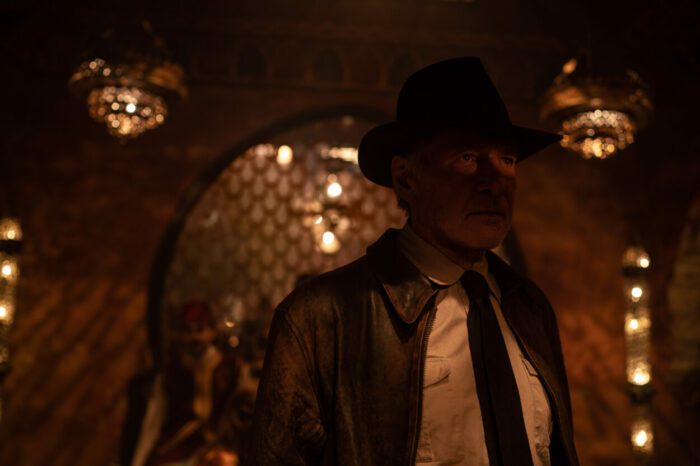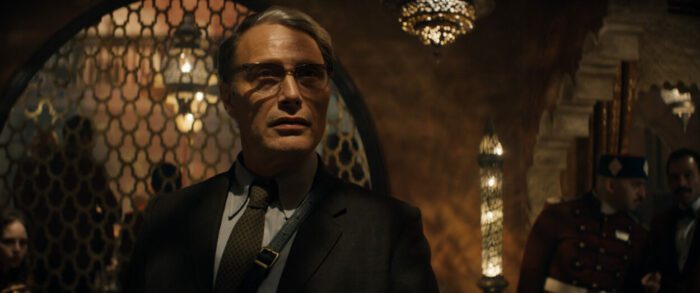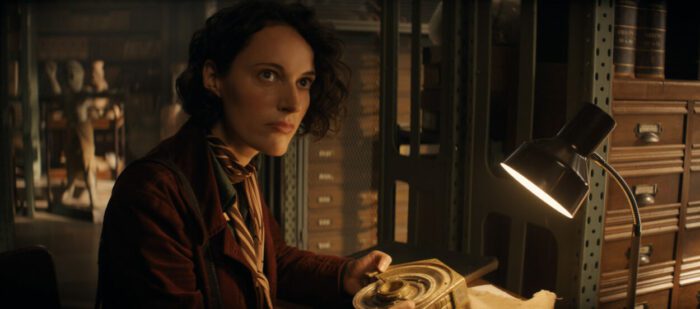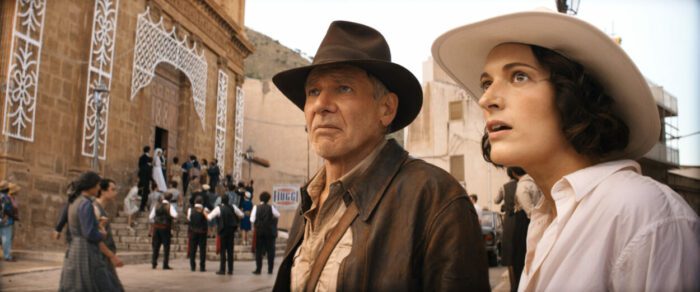Since we’re diving into the realm of human history with Indiana Jones and The Dial of Destiny, let’s take a big swig of it. In his essay Lacaenarum Apophthegmata, the Greek philosopher Plutarch documented the “Moralia,” or matters of custom, of Spartan women. Used to great effect by Lena Headey’s Queen Gorgo in 2006’s 300, Spartan women would hand their sons or husbands their shields for battle and extol “Either this or upon this,” meaning they either come back victorious or dead.
That Spartan edict might be an extreme request to make for Harrison Ford’s Dr. Henry Walton Jones, Jr.. Courage radiates out of every pore of the retiring 80-year-old archaeology professor. He certainly is not afraid to die. For a majority of the expansive 154 minutes of Indiana Jones and the Dial of Destiny, the title character’s intrepid bravery is all you need. However, this culminating episode is not a question of valor. Like Toy Story 4 before it, this is a question of worth.

For the second film in 34 years, a new Indiana Jones film cheapens the perfect ending they already had. Make no mistake, the sunset ride of Indiana Jones the the Last Crusade was a “come back with your shield or on it” moment that cannot be topped. Yet, here we are, watching a studio milk an intellectual property they purchased after its peak for one more (albeit, shared) box office windfall. The producers are calling Indiana Jones and the Dial of Destiny a “one last time” type of excursion. It is indeed that. It is one last time to wish they left it alone or had a better story worth telling.
Directed by the esteemed two-time Oscar nominee James Mangold (Logan, Ford v Ferrari), the romp starts with the appropriate sound of a ticking clock before an extended flashback sequence takes us to Poland towards the end of World War II. Dr. Jones (a digitally smoothed Ford) has been apprehended by the Nazis pursuing the Lance of Longinus in order to keep the heralded religious artifact from the Führer. While dueling on a military train against his scientific German counterpart Jürgen Voller (professional movie villain Mads Mikkelsen), the attention turns to another antiquity– the Antikythera of Archimedes, a doohickey split in two from the 2nd century B.C. rumored to open up fissures in time when their halves are reunited and operated properly.

The best Indiana Jones iterations are about the MacGuffin, meaning exposition is required at several steps along the way for those light on their retained World History facts from high school or college. True to the chestnut of the journey vs. the destination, those imaginative objects of massive importance come with the need to build myths and suspend disbelief. Yet, for some reason of invisible escalation, the chosen MacGuffins keep getting grander and sillier with each new movie and undone conclusion. The aliens of The Kingdom of the Crystal Skull left a bad taste in many mouths, and The Dial of Destiny is jumping an ocean of sharks to dabble with the element of time travel. Get our diuretic medications ready.
Fast-forward to the hippy-tastic summer of 1969. Indiana Jones is estranged from his wife and retiring from his time as a professor in New York City when the old past of the Antikythera comes bubbling back to the surface. Indy is approached by Helena Shaw (Fleebag Emmy winner Phoebe Waller-Bridge), his goddaughter and the daughter of his Poland operation partner Basil Shaw (Toby Jones). Quite the swashbuckling archaeologist herself, she pitches Jones to continue the quest to complete Archimedes’ fabled invention. Naturally, she’s not alone in this endeavor.

Jürgen Voller returns from the past as well, masquerading as a NASA physicist “Dr. Schmidt,” lauded with the program’s success and backed by government assets. He and his hit squad of cronies (composed of the overqualified Boyd Holbrook, The Resident’s Shauna Renée Wilson, and the hulking bodybuilder Olivier Richters) lock their sights on Helena and Indy during Manhattan’s ticker-tape parade for the returned Apollo 11 astronauts. With some help from allies young (a semi-cheap “Short Round” substitute named Tommy played by newcomer Ethann Bergua-Isidore) and old (Antonio Banderas’ salty diver Renaldo), the new duo try to stay one step ahead of the reorganized Nazis. From there, Indiana Jones and the Dial of Destiny leaps from one globe-trotting and booby trap-filled chase to another.
The replacement of practical effects for CGI wizardry dilutes the Indiana Jones experience entirely. In the 1980s films, visual effects were only capable of so much. They created the illusion that the impossible was possible because the climactic spectacles of those aforementioned MacGuffins were still bound to their settings and achieved with some measure of spit-and-glue movie magic. Moreover, the overall paths to get to those vital items were fraught with more realistic entanglements and heady scientific challenges. Now, the extra embellishments make it all look no-f’n-way impossible thanks to the plainly obvious digital marionette strings at every turn.

Indiana Jones and the Dial of Destiny greatly increases the greenscreen and digital layering to an over-saturated level. Try as the stunt coordinators may, just like man-eating ants and terribly fake vine-swinging in The Kingdom of the Crystal Skull, it is increasingly difficult to detect anything remotely real in Mangold’s finale in several set pieces, from the smallest creepy critters and puffs of smoke to the actors themselves. While Mangold, his go-to and Oscar-winning Ford v Ferrari editing team led by Michael McCusker, and his trusty 3:10 to Yuma cinematographer Phedon Papamichael slickly emulate Steven Spielberg’s panache for playful action choreography backed by a peppy score from the legendary John Williams, the frames are still filled with too much artifice.
The onslaught of CGI intrusions is not a believable mesh and removes a tremendous amount of the peril that felt so palpable back when the tarantulas were real and the only thing stopping a cobra was a hidden pane of glass. Who knew something overstuffed would end up so empty at times? In the end, the only venerated vessel that probably matters for any capacity is Harrison Ford himself.

To quote Raiders of the Lost Ark, “it’s not the years, it’s the mileage”. This isn’t the Harrison Ford of 42 or even 15 years ago. There was no way the multi-generational movie star’s endurance wasn’t going to be limited next to its former titanic heights. Therein lies one of great deficiencies of Indiana Jones and the Dial of Destiny cheating with digital effects every chance it gets.
In that blockbuster level of regard, the octogenarian cedes more than a little of the action and spotlight to Phoebe Waller-Bridge and his digitally de-aged stunt doubles. She’s an engaging new tweener of a heroine and an instigator. Regardless of that reduction, the necessary counter compensation for that was finding an adventure that kept a senior Indiana Jones involved intellectually and emotionally. Director James Mangold and his three writing partners—noted hit-or-miss Spielberg partner David Koepp and the brotherly script doctor team of Jez and John-Henry Butterworth—accomplished, at best, only halfway in that capacity.

Scene to scene, the emotional and intellectual investment level of Harrison Ford wavers with the material. In some moments, notably the ones free from most of the manic menageries, the pieces line up and click. Ford will convey his character’s passionate spine for the missions of archaeology or the bonds of his lasting relationships. John Williams will hit a cue and Harrison will swirl our loyal sentiment and inspire the old derring-do we love. In other moments, unfortunately, Ford looks forced bounding between convoluted plot points through one motorized wringer after another to get to something he can really sink his teeth into.
The latter may outnumber the former, which is where the cheapening of that previous sunset ride becomes more and more indisputable. Admittedly, it is wonderful just being around Harrison Ford in hero mode. Indiana Jones and the Dial of Destiny can wear you down to enjoy the character you love and discard the jumbled mess around him if it means sharing his cinematic oxygen a little longer. For many, that might be enough. But again, those fleeting feelings and little hits were not worth undoing what was already damn-near perfect long ago for sad and diminished returns. Indiana Jones has become a time capsule and should have stayed a time capsule. You can’t get that same kind of sunset ending two or three times.



